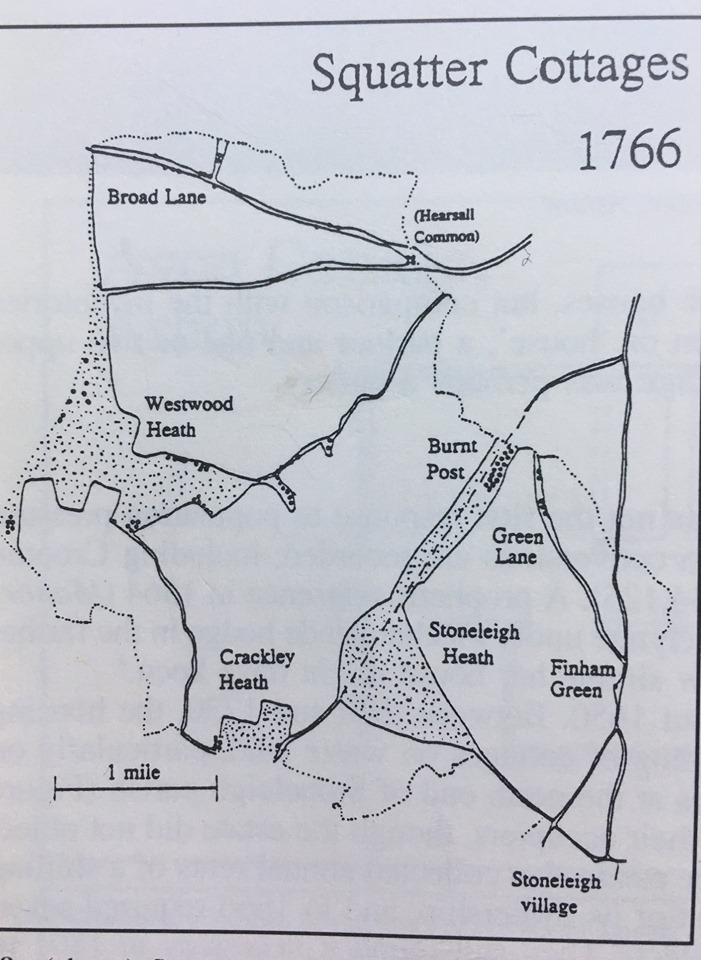Squatter Cottages
- westwoodheathra
- Jul 15, 2019
- 4 min read
Updated: Dec 2, 2019
We are all aware of the current housing shortage in the country and can see the building sites springing up everywhere in the landscape in an attempt to provide both private and social housing. We are no strangers to this in Westwood Heath, and as with so much that happens…it was ever thus!
Homes for the poor built by the poor
Poverty, homelessness and associated vagrancy was a problem throughout the 16th and 17th centuries, especially with an increase in population in the second half of that period.
In many parts of England, very basic dwellings, known as squatter cottages, were constructed by the homeless poor. These appeared in many instances literally overnight, since a common belief had arisen amongst the poor that providing they could build their house in a day and have a fire lit and smoke issuing forth from the chimney by sunset, their homes could remain.
This notion – although having no basis in law – had become common practice. Consequently, the homes were built hastily out of materials that were cheap or free and easily to hand, such as wattle and daub. Many of these were soon torn down by irate landowners, but those that remained were often encased in brick or stone at a later date to make them more solid.
This haphazard approach to house building caused inconvenience to landowners and others living locally and so an act of parliament was passed, The Erection of Cottages Act (1588). This prohibited the construction of any dwelling that did not have at least 4 acres of land assigned to it out of the freehold or other heritable land belonging to the person responsible for its construction – thus making it much harder for the squatters to build. If they fulfilled this requirement, they were allowed to settle permanently. However, landowners did have some discretion to grant permission to those who did not have freehold or rights of inheritance on the land, if the individual had been granted exemption through Quarter Sessions on grounds of poverty. This prevented vagrancy and dependence on parish relief and allowed an independent labourer to house himself and his family, grow produce on his 4 acres to feed them and to work for part of the year for farmers or tradesmen to supplement his income. Restrictions to this were applied: anyone building a squatter cottage was not allowed to take in lodgers or to sell the cottage, since it belonged to the land owner.
The situation in Westwood Heath
There had been population pressure on housing in Stoneleigh parish from the 16th Century, with barn conversions (these were hovels, not what we think of today!) noted towards the end of that period. Rudimentary housing was referred to as early as 1564, as 2 shillings rent was collected from “a pore woman dwelynge under Fletchamstede hedge in the farther side of Westwode”.
From c1650-1730, cottages were built on wasteland in Westwood Heath and on the verges of the wide lanes lying at the north end of Stoneleigh parish. These seem to have been erected by their occupiers, with the approval of Stoneleigh estate, which oversaw the laying out of plots for the purpose. The estate collected a small annual rent of 1 or 2 shillings as an acknowledgement that the estate owned the dwelling. On occasion, this must have required greater emphasis by the occupiers being required to make a specific declaration; on 9th April 1666, 12 occupiers had to state formally that the estate, not themselves, owned their cottages. These related to 7 cottages on Crackley Heath and Westwood Heath and also to 2 barns and a parcel of land.
In 1801 a handbill was printed warning against the sale of these cottages by enterprising occupiers; a situation which had clearly become a problem.
Rents for the squatter cottages in Westwood Heath were administered separately from main estate rentals although the dwellings were included in the 1766 survey of Stoneleigh parish. A further survey in 1807 revealed the basic conditions within the cottages and their distribution throughout the area. In 1816, Westwood Heath and other common land was enclosed. Many of these cottages were demolished then and the rest later, with the estate steward noting, “the cottages are in general miserable buildings”. Because of their scattered nature it was felt not worth keeping them since they would need roads “in so many directions”.
Images:
Squatter cottages in Stoneleigh parish, 1766. Each dot marks the position of a cottage on the waste, as recorded on the 1766 map. (Plan produced by Nat Alcock for “People At Home, 1993, and reproduced with his kind permission).
Cottage sale handbill, 1801. CC-BY-NC-ND Image courtesy of Shakespeare Birthplace Trust (ref DR18/3/47/48/4).
Sources:
Nathaniel Alcock, People At Home. Phillimore, 1993.
John Broad. Housing the Rural Poor in Southern England 1650-1850. Paper accessed at www.bahs.org.uk
Steve Hindle. On the Parish?: The Micro-Politics of Poor Relief in Rural England c1550-1750. Clarendon Press, 2004.
As ever, please get in touch with questions, comments and (polite!) suggestions. Also we would love you to share photos and memories of WH.
PM me or comment or email







Comments